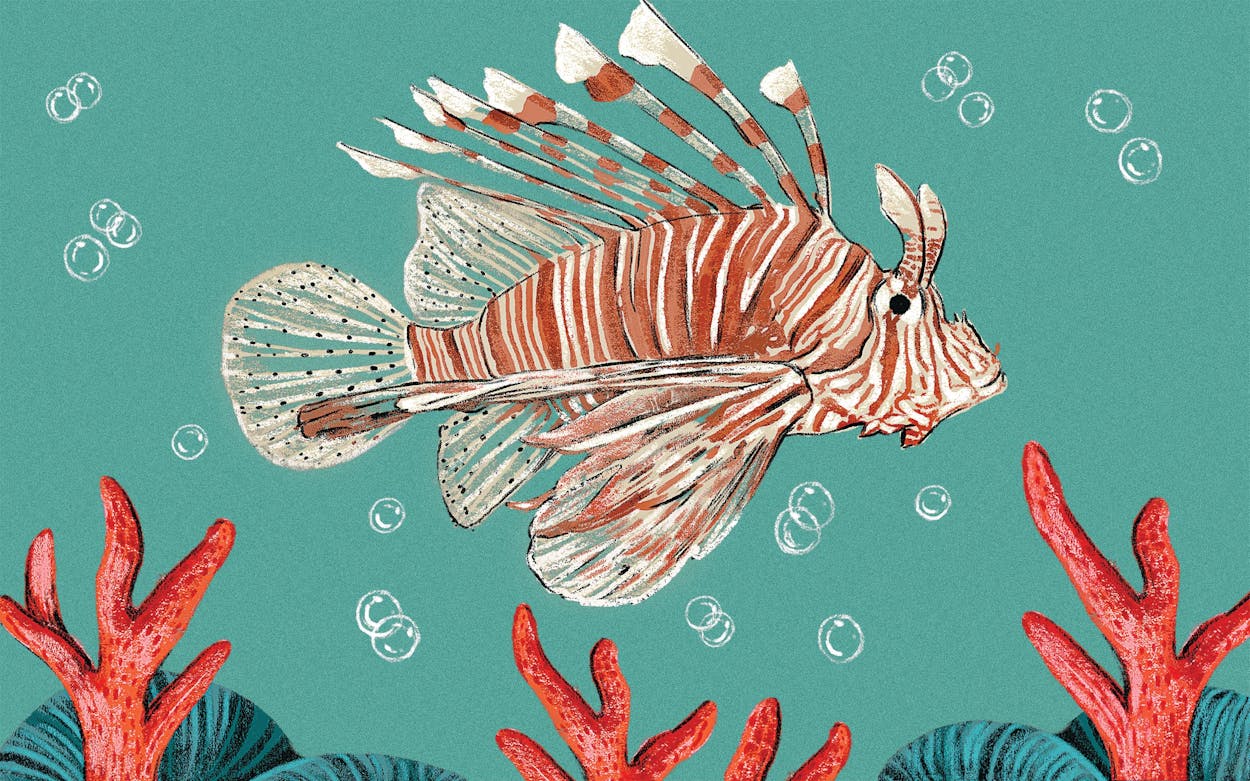Latin name: Pterois volitans
Size: Twelve to fifteen inches long
Texas Habitat: The Gulf Coast
As the majestic lionfish glides through the ocean, its eighteen spines ripple like silk scarves in a breeze. This flashiest of fishes, with its eye-catching brown or reddish and white stripes, trolls the Gulf as a top predator, just as its namesake big cat rules the savanna. Its gorgeous fins fan out around its body the way a mane frames a lion’s face. The sea creature’s beauty belies its brutality: get too close, and the spines that appear soft and silky reveal themselves as deadly weapons, injecting venom that immobilizes prey and would-be predators and leaves humans writhing in pain. Lionfish also reproduce with shocking speed, releasing 30,000 eggs every three days. This is one of our state’s most ruthless invasive species.
How long have lionfish lived near Texas?
Native to the South Pacific and Indian Oceans, they began to appear off the Florida coast in the mid-eighties. In 2011 the first lionfish seen near Texas was spotted about one hundred miles from Galveston, at Flower Garden Banks, a national marine sanctuary. Now they lurk across the Gulf Coast and
appear unstoppable, says Leslie Hartman, the Matagorda Bay ecosystem leader with Texas Parks and Wildlife. “As a biologist, I love and hate them simultaneously,” she says. “They’re the feral hog of the ocean.” Both pests are highly intelligent, reproduce rapidly, and have few natural predators.
Why are they a problem?
Their voracious appetite upsets the delicate balance of life on coral reefs. One study found that a single lionfish on a reef can reduce the number of native fish surviving to adulthood by 79 percent. Many of the small species that lionfish devour keep reefs healthy by eating algae. “Reefs can be overgrown by algae very easily,” says Hartman. “Eventually the whole structure can collapse.”
How can we stop them?
Spearfishing! Flower Garden Banks will host the Lionfish Invitational, a program aimed at combating the species, three times this summer. “Almost three hundred lionfish were removed last year,” says research operations specialist Olivia Eisenbach. Bonus: you can eat the meat. “These fish are delicious,” she says.
Are there any other strategies to keep them in check?
Steve Gittings, the chief scientist for NOAA’s Office of National Marine Sanctuaries, has designed a lionfish trap to catch the creatures, but it hasn’t yet been widely adopted. There’s also an effort to put lionfish on more menus. The challenge is creating a supply chain for commercial fishing. “It’s not very common in Texas, but in Florida multiple restaurants are selling lionfish,” Eisenbach says. For now, if you’re not an experienced spearfisher, you can do your part by eating a lionfish taco next time you’re on vacation in the Sunshine State. Restaurants in Houston and New Braunfels briefly served lionfish, but both have since shuttered. If you spot it on a Texas menu, we’d like to hear about it.
Finally, in Honduran waters, some dive masters are even trying to train sharks to attack and eat lionfish, so that these pests will have to contend with more predators. But that’s controversial, in part because interfering with Mother Nature is what got us into this mess in the first place: Lionfish are believed to have spread on the Gulf Coast after a few unscrupulous aquarium owners dumped their unwanted exotic pets. But with time, our sharks should catch up and learn how to hunt the (relatively) new arrivals, Eisenbach says: “That’s reason for hope.”
This article originally appeared in the May 2024 issue of Texas Monthly. Subscribe today.
- More About:
- Critters








